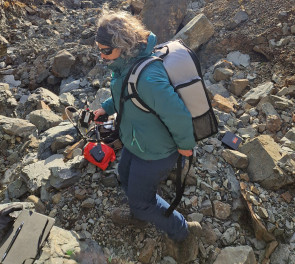
Dr Julia Semprich
Research Fellow
School of Environment, Earth & Ecosystem Sciences
Biography
Professional biography
I am a petrologist and planetary scientist studying processes in the crust and mantle of rocky planets in our and other solar systems and implications for their habitability. As a Research Fellow in AstrobiologyOU at the Open University, my research is focused on understanding the role of fluids in the crust of terrestrial planets, particularly Mars and Venus. Prior to that I was the Graham Ryder Fellow at the Lunar and Planetary Institute in Houston studying hydrothermal alteration in the martian crust and surface alteration of Venus. As a post-doctoral Research Fellow at the University of Campinas, I studied the formation of Earth's Archean crust using petrological and trace element models. I received my PhD in Geosciences at the University of Oslo, Norway.
2020 - present: Research Fellow, AstrobiologyOU, The Open University, Milton Keynes, UK
2018-2019: Graham Ryder Fellow, Lunar and Planetary Institute, USRA, Houston, Texas, USA
2017: Visiting Fellow - The Open University, Milton Keynes, UK
2014-2016: Post-doctoral Research Fellow, University of Campinas, Brazil
2013: PhD in Geosciences, University of Oslo, Norway
Research interests
My research interests centre around processes in the crust and mantle of terrestrial (Earth-like) planets in our Solar System and beyond and specifically the role of fluids in planetary evolution from crust formation to alteration. I used a combination of approaches including modelling, field measurements, analytical work, and experimental approaches to understand metamorphic and magmatic processes in the crust and their implication for habitable environments.
Venus is our closest neighbour and very similar in size and mass to Earth and yet has taken a fundamentally different evolutionary parth. While Eath has surface water and hosts life, the conditions on Venus are caustic with temperatures resembling a pizza oven (~470 °C), pressures of 90 bars, and a CO2-dominated atmosphere. There are some indicators, however, that Venus may have had more water in the past and could have been more hospitable. In my research I use models and experiments to better understand how the venusian crust formed which included understanding the role of water. This is particularly exciting since several mission will be exploring Venus in the late 2020s and early 2030s such as NASA's DAVINCI and VERITAS missions, and ESA's EnVision mission. I am a Co-I on the EnVision mission's VenSpec Suite, a multispectral imaging system that will measure atmorpheric, thermal, and compositional signanatures to search for volcanic activiy and compile a global map of the composition of the venusian surface.
In many ways, Mars is the opposite of Venus. It is only about half the size of Earth and has a very thin atmosphere, resulting in extreme fluctuations in surface temperatures which are predominantly too low for surface water to exist at present. Decades of Mars science has shown evidence of long-lasting water activity with two NASA rovers Curiosity and Perserverance still exploring different parts of the planet. While the surface may presently not be a habitable environment, conditions in the subsurface could be much more favorable for microbial communities. I study fluid-rock interactions in hydrothermal systems, where fluids are heated up by either volcanic activity or meteorite impacts and could provide the temperatures and nutrients to created habitable subsurface environments on Mars. My approach combines modelling with an analogue hydrothermal system in Vatnajöjull National Park, Iceland (see header image). The anaologue site is composed of a sequence of mainly basaltic rocks formed by a central volcano around 5-6 million years ago and was then exposed to hot fluids forming new minerals deposited as veins. The goal of the field work is to characterise the hydrothermal minerals and understand the extent of the alteration, which can then be compared to observations from Mars.
The differences recorded in terrestrial planets in our Solar System suggests that planets in other solar systems can form and evolve in a variety of settings. I am interested in the role of water and other fluids in the formation and evolution of planetary crusts in various settings, the implications for habitble world, and how they can be detected by observations and measurements.
Teaching interests
I am a member of the module team for S209 Earth Science specialising in igneous and metamorphic petrology. I am specifically interested in making geology more accessible in the form of virtual field trips and in the OU's extended reality studios. Together with a drone team, we have created a 3-D model of part of the field area in Iceland.
Impact and engagement
2024-2025 Distinguished Lecturer for the Mineralogical Society of America.
The future of Venus research, Glasgow Science festival.
15 minutes on Mars interactive (OpenLearn)
The serach for water on Mars (OpenLearn)
Milton Keynes International Festival, 2023, Cabaret of Ideas.
Bang Goes DG 2022 and 2023.
Bluedot festival 2023.
Publications
Book Chapter
The Archaean Karelia and Belomorian Provinces, Fennoscandian Shield (2014)
Journal Article
Metamorphism of Venus as driver of crustal thickness and recycling (2025)
A dunite fragment in meteorite Northwest Africa (NWA) 11421: A piece of the Moon’s mantle (2023)
Askival: An altered feldspathic cumulate sample in Gale crater (2023)
Phase Equilibria Modeling of Low-grade Metamorphic Martian Rocks (2019)
Phase equilibria and trace element modeling of Archean sanukitoid melts (2015)
Presentation / Conference
Influence of Thermal Gradient and Water Content on the Composition of Venusian Basalts (2024)
Modeling Melt Fractionation in the Venusian Mantle and Implications for Basalt Composition (2024)
Compositional Variation of Venusian Melts as A Function of Thermal Gradient and Protolith (2023)
Modelling possible chemical evolution pathways during freezing of Europa’s ice shell (2023)
Unraveling Venus' Geological Past: Linking Melt Compositions to Reservoir and Depth (2023)
Modeling the crystallization of Martian igneous compositions (2022)
Brine evolution and transport-driven fractionation of ocean fluids within Europa’s icy shell (2021)
From the San Rafael Swell to Mars (2020)
Low-grade metamorphic phases on Mars as a function of CO2-H2O fluid compositions (2019)